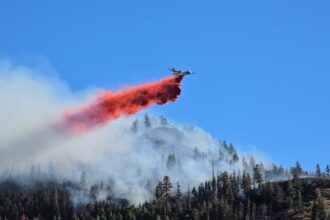The acrid smell of smoke hangs over vast stretches of the Canadian Prairies this week as rapidly expanding wildfires have triggered unprecedented evacuation orders across Manitoba, Saskatchewan, and Alberta. More than 10,000 residents have fled their homes in what emergency officials are calling one of the most challenging early wildfire seasons in recent memory.
“We’re witnessing fire behavior that’s typically reserved for mid-summer,” said Marcus Thompson, Manitoba’s wildfire operations chief, during an emergency briefing yesterday. “The combination of unseasonably high temperatures, minimal spring precipitation, and strong winds has created perfect conditions for these fires to grow explosively.”
In northern Saskatchewan, the situation turned critical Tuesday when flames threatened to cut off the only evacuation route from La Ronge, prompting authorities to call in Canadian Armed Forces aircraft to assist in evacuation efforts. Military CC-130 Hercules transport planes arrived Wednesday morning, evacuating nearly 400 residents with critical medical needs as smoke reduced visibility to dangerous levels.
The fires have already consumed more than 130,000 hectares across the three provinces, according to data from Natural Resources Canada. That’s nearly triple the 10-year average for this point in the season. In Manitoba alone, firefighters are battling 23 active fires, seven of which are classified as out of control.
Evacuee Jennifer Redsky described the harrowing journey from her community near Swan River, Manitoba. “We had 30 minutes to grab whatever we could,” she told me at an emergency shelter in Winnipeg. “The sky was orange, ash was falling like snow, and we could see flames on both sides of the highway as we drove out. I’ve never been so scared.”
Provincial emergency measures organizations have established evacuation centers in Regina, Saskatoon, Winnipeg, and Edmonton, where displaced residents are receiving temporary housing, food, and medical assistance. The Canadian Red Cross has deployed disaster response teams to all locations, with volunteers working around the clock to register evacuees and distribute essential supplies.
Climate scientists point to this emergency as further evidence of shifting weather patterns affecting Western Canada. Dr. Elena Markov, climatologist at the University of Alberta, noted that “the data shows prairie regions experiencing 1.6°C higher spring temperatures compared to historical averages, coupled with a 22% decrease in spring precipitation over the past decade. These conditions significantly extend the fire season.”
For communities already evacuated, the waiting game has begun. Officials estimate some residents may be displaced for two weeks or longer, depending on fire containment progress and infrastructure damage assessments. Satellite imagery shows several fires have already damaged power transmission lines, complicating the eventual return.
“This isn’t just about fighting fires anymore—it’s about adapting to a new reality,” said Alberta Premier Danielle Smith during a press conference in Edmonton yesterday. “We’re investing in additional firefighting resources, but communities need long-term resilience planning against these increasingly frequent threats.”
For the latest information on evacuation orders and wildfire status, residents can visit their provincial emergency information websites or follow updates on our CO24 Breaking News page. Our team will continue to track these developing situations and provide updates as they become available.
The economic impact extends beyond immediate firefighting costs, with insurance analysts projecting potential claims exceeding $500 million if fires reach more populated areas. Business disruptions, especially in resource sectors vital to the prairie economies, could further compound financial pressures in regions still recovering from pandemic-related challenges. For analysis of the economic implications, see our in-depth coverage at CO24 Business.
As evacuation orders expand and smoke continues to impact air quality across four provinces, this early-season crisis signals what may be a long and challenging summer ahead for Western Canada’s firefighters, communities, and emergency response systems.

























